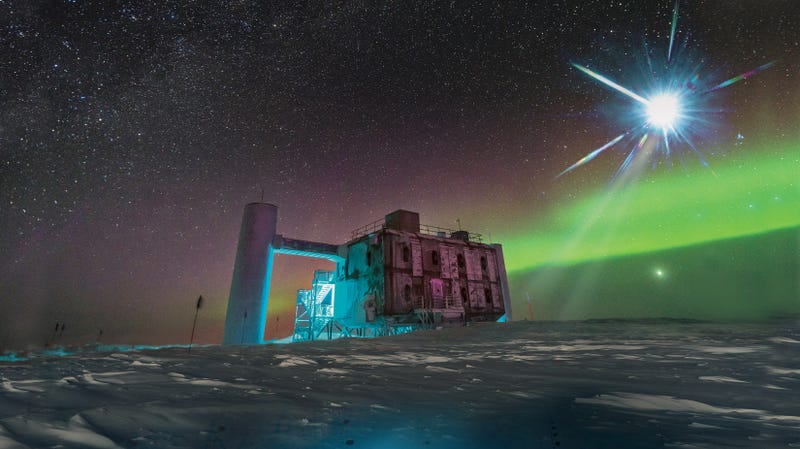 Artist’s enhancement of IceCube photoGraphic: NSF/IceCube
Artist’s enhancement of IceCube photoGraphic: NSF/IceCube
Today, scientists made a huge announcement: Telescopes around the world recorded a source of mysterious, ultra-high-energy cosmic rays, the highest-energy particles that hit the Earth. It all started with a text message.
The recent discovery has, at least partially, solved a hundred-year-mystery—the identity of a space object that could possibly send particles with energies a billion times higher than the particles produced at the Large Hadron Collider. The answer was more or less what scientists had predicted it would be, but finding the answer was an enormous feat that required international coordination. It relied on a worldwide notification system that is used in case of incredible space events. It was a feat of this new era of “multimessenger astronomy.”

Cosmic Ray Mystery Finally Cracked Thanks to Supermassive Black Hole Beaming Energy Straight at…
Every so often, protons and even entire atomic nuclei strike the Earth with extremely high…
Read more Read
“We’re fortunate to live in an era when we can make discoveries that simply would have been impossible only a decade ago,” France Córdova, director of the National Science Foundation, told Gizmodo in an email.
Multimessenger astronomy means exactly what it says—astronomy that uses information conveyed by multiple kinds of messengers. “Light,” or electromagnetic radiation, comes in many forms, like gamma rays, x-rays, ultraviolet, visible light, infrared, microwave, and radio waves. This has traditionally been astronomers’ only tool to peer into the cosmos, but light alone can only tell us so much. Today’s discovery adds a second “messenger” to the toolbox: a very high-energy neutrino. Like light, neutrinos can travel in a straight line through the Universe without being bent by magnetic fields, but single high-energy neutrino that sparked today’s announcement added extra information, since only the mysterious, ultra-high-energy cosmic rays could have produced it.
The IceCube Neutrino Observatory spotted and calculated the path traveled by the neutrino on September 22, 2017, and its computers immediately realized the detection was noteworthy.
“IceCube decides what’s worth sending it out,” Anna Franckowiak, staff scientist at the Deutsches Elektronen-Synchrotron in Germany, told Gizmodo. “We send only the most interesting events, which usually means they’re high-energy events. That means there’s a high probability that it’s really a cosmic neutrino, and isn’t just a neutrino produced in the atmosphere.”
The experiment sent a notice over the Gamma-ray Coordinates Network (GCN) 43 seconds later to anyone signed up to receive these alerts. Four hours later, a more detailed message went out over the same network. The circulars and notifications can either come immediately over networks, or can come a few seconds after their issuance via text message or email. The second alert read:
On 22 Sep, 2017 IceCube detected a track-like, very-high-energy event with a high probability of being of astrophysical origin. The event was identified by the Extremely High Energy (EHE) track event selection. The IceCube detector was in a normal operating state. EHE events typically have a neutrino interaction vertex that is outside the detector, produce a muon that traverses the detector volume, and have a high light level (a proxy for energy).
After the initial automated alert, more sophisticated reconstruction algorithms have been applied offline, with the direction refined to:
Date: 22 Sep, 2017
Time: 20:54:30.43 UTC
RA: 77.43 deg (-0.80 deg/+1.30 deg 90% PSF containment) J2000
Dec: 5.72 deg (-0.40 deg/+0.70 deg 90% PSF containment) J2000
We encourage follow-up by ground and space-based instruments to help identify a possible astrophysical source for the candidate neutrino.
Soon after, a few observatories, including the ANTARES neutrino telescope in the Mediterranean sea, the MAGIC Telescopes on the Canary Islands, the High-Energy Stereoscopic System (H.E.S.S.) in Namibia, and the Earth-orbiting Swift X-ray telescope, followed up with varying levels of success, issuing update notices of their own.
The eureka moment came on September 28, when scientists realized that the Fermi Large Area Telescope, which surveys the skies for gamma rays, found a potential source in their catalogue that matched the direction from which the neutrino arrived. That source was a blazar, the particle-spewing, supermassive black hole at the center of galaxy TXS 0506+056. They published an Astronomer’s Telegram documenting the source. Others began to observe the black hole based on this info, thus completing the multimessenger story.
If this story sounds familiar, it’s pretty similar what happened during the first discovery of two neutron stars colliding, which was announced to much fanfare last October. Gravitational wave observatories like LIGO also issue alerts over the GCN, but observatories must sign a contract to view them.
This type of multimessenger science is very new. After the 1987 supernova SN 1987A, this is perhaps only the third major multimessenger discovery, after the colliding neutron stars. It’s taken a lot of work to get to this point.
“These improbable impacts are what we’re focused on today, but think about everything the research community had to do to make the detection of neutrinos possible,” Córdova said. “We had to build a facility at the South Pole and equip it with incredibly sensitive instruments. We had to link that facility to global satellites. And hundreds of scientists had to put in years of work, building on decades of breakthroughs made by other researchers.”
Multimessenger astrophysics is a “big idea” that will guide the National Science Foundation’s long-term plan. It hopes to see more multimessenger proposals from the astrophysics community. “But on top of proposals we need funds,” NSF program director Vladimir Papitashvili told Gizmodo. There’s no getting around it, the government helps fund these big projects.
But for now, we’ve got the GCN and Astronomer’s Telegram linking together telescopes and observatories across the world, sending texts and emails in order to push forward the most exciting things happening in astronomy.